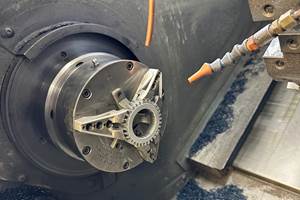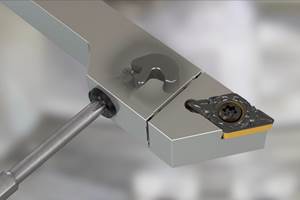Get The Feed Rate Right When Thread Milling
Does your machine control specify radial feed rate from the edge of a tool or its center? Not knowing can cause much longer cycle times or greatly reduced tool life during thread milling operations.
Share






Shops that adopt new machining practices face learning curves of varying slopes. Basic inexperience with new approaches means some process-optimizing details can be overlooked, too.
Consider thread milling. An alternative to tapping, thread milling makes it possible to use a single tool to thread a variety of diameters that share a common pitch. In addition, it has the ability to machine threads very close to the bottom of a blind hole. Thread milling also generates short, controllable chips (instead of long, stringy ones) that are readily evacuated out of both blind and through holes. Specifying the correct radial feed rate in the machining program is the key to achieving short cycle times and long tool life during thread milling operations. It’s possible, though, that shops new to thread milling don’t know if they’re using the right rate.
This is because some machine controls specify feed rate at the center of a tool, while others use the feed rate at a tool’s outer edge. (In a circular movement, the feed at the center of the tool is slower than the feed at the cutting edge.) Inexperienced operators might not know whether the “F” command, which defines the radial tool feed rate in a thread milling program, refers to the feed at the tool’s center or its edge.
Vargus USA, a manufacturer of Vardex thread milling tools, highlights the significance of using the correct feed rate with this example. For a 4.8-mm thread mill used to create an M6 x 1 thread, the feed rate at the edge of the tool is 238 mm/min. Conversely, the feed rate at the center of that tool is only 47 mm/min. Moving the tool too slowly leads to extended machining time (five times longer in this example). On the other hand, a tool that moves too fast can experience high cutting loads that significantly reduce tool life.
Vargus USA offers free software that can ensure operators use the correct radial feed rate during thread milling operations. The company’s TM Gen is a PC-based program that guides users through a few simple steps to define the thread milling application. It then provides all the information needed to run the threading job. This includes the feed rates for both the tool center and edge as well as calculated cycle times for both feed scenarios. If the actual machining time is drastically different than what the software calculates, then the machine control is moving the thread mill at the wrong feed rate. Operators can then change the feed to the correct value as provided by the software.
The TM Gen software creates G-code for many popular controls, including Fanuc, Heidenhain, Mazatrol, Mitsubishi and Siemens. It is available for free download at the company’s Web site (vardex.com). Vargus USA also offers a similar software program called TT Gen for thread turning applications. The TT Gen software provides a comprehensive, printable report that recommends proper insert and toolholder, carbide insert grade, and feeds and speeds. The latest version of this software supports 10 languages as well as both inch and metric measurement units.
Related Content
The Future of High Feed Milling in Modern Manufacturing
Achieve higher metal removal rates and enhanced predictability with ISCAR’s advanced high-feed milling tools — optimized for today’s competitive global market.
Read MoreChuck Jaws Achieve 77% Weight Reduction Through 3D Printing
Alpha Precision Group (APG) has developed an innovative workholding design for faster spindle speeds through sinter-based additive manufacturing.
Read MoreQuick-Change Tool Heads Reduce Setup on Swiss-Type Turning Centers
This new quick-change tooling system enables shops to get more production from their Swiss turning centers through reduced tool setup time and matches the performance of a solid tool.
Read MoreLean Approach to Automated Machine Tending Delivers Quicker Paths to Success
Almost any shop can automate at least some of its production, even in low-volume, high-mix applications. The key to getting started is finding the simplest solutions that fit your requirements. It helps to work with an automation partner that understands your needs.
Read MoreRead Next
Machine Shop MBA
Making Chips and Modern Machine Shop are teaming up for a new podcast series called Machine Shop MBA—designed to help manufacturers measure their success against the industry’s best. Through the lens of the Top Shops benchmarking program, the series explores the KPIs that set high-performing shops apart, from machine utilization and first-pass yield to employee engagement and revenue per employee.
Read MoreAMRs Are Moving Into Manufacturing: 4 Considerations for Implementation
AMRs can provide a flexible, easy-to-use automation platform so long as manufacturers choose a suitable task and prepare their facilities.
Read More




















